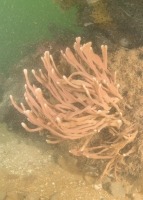
(Photo: Claire Goodwin)
Mermaid's Glove Sponge
Haliclona oculata
Branched yellow to brown sponge. Branches slightly flattened with a velvety surface. Rows of oscules (holes) along the branches. Height can be up to 30 centimetres.
Authority
Linnaeus, 1759
Classification Details
Phylum: Porifera (sponges); Class: Demospongiae (siliceous sponges).
Habitat
Attaches to bedrock and stones. Found on both sides of the North Atlantic: from the Gulf of St. Lawrence to North Carolina on the west and Russia to Portugal on the eastern side. Occurs from the infralittoral down to around 100 metres.
Diet
Sponges feed on small particles in the seawater. 80% of their diet is bacteria-sized particles (<0.5 micrometres in diameter). They suck seawater into a network of canals in their body using a current generated by cells called choanocytes. The choanocytes also capture the food particles.
Reproduction
Hermaphrodite: individuals are both male and female. Sperm is released into the water column, then sucked up by another sponge and used to fertilize its eggs. The sponge then broods the resulting embryos in its body tissue until they develop into free-swimming larvae that are released into the seawater. After a few days in the seawater, the larvae settle and develop into adult sponges.
Fun Facts
Scientists have found that bioactive compounds (chemicals) from this sponge have anti-fungal properties and potential for treating liver cancer.
References
Goodwin C (2017) Field guide to the sponges of the Bay of Fundy. Huntsman Marine Science Centre. Available from https://www.researchgate.net/publication/319433507_Field_Guide_to_Sponges_of_the_Bay_of_Fundy .
Kiem PV, Thanh NTV, Hang DTT, Cuc NT, Nhiem NX, Yen PH, Anh HLT, Tai BH, Thao DT, MInh CV (2015) Cytotoxic Constituents from Vietnamese Marine Sponge Haliclona oculata (Linnaeus, 1759). Letters in organic chemistry 12, 708–712.
Lakshmi V, Shukla PK (2013) Antifungal property of marine sponge Haliclona oculata (Kirkpatrick). Natural products 9, 339–344.
Van Soest RWM, Boury–Esnault N, Hooper JNA, Rützler K, de Voogd NJ, Alvarez B, Hajdu E, Pisera AB, Manconi R, Schönberg C, Klautau M, Kelly M, Vacelet J, Dohrmann M, Díaz M.-C, Cárdenas P, Carballo JL, Ríos P, Downey R and Morrow CC (2019) Haliclona oculata (Linnaeus, 1759). Accessed at: http://www.marinespecies.org/porifera/porifera.php?p=taxdetails&id=132833 Accessed online 20 January 2020.
Van Soest R, Picton B, Morrow C (2000) Halichondria sitiens – Sponges of the NE Atlantic. http://species-identification.org/species.php?species_group=sponges&id=251 Accessed online 20 January 2020.


